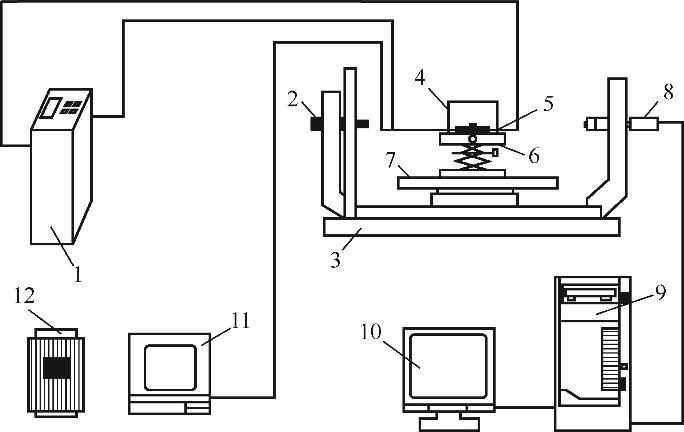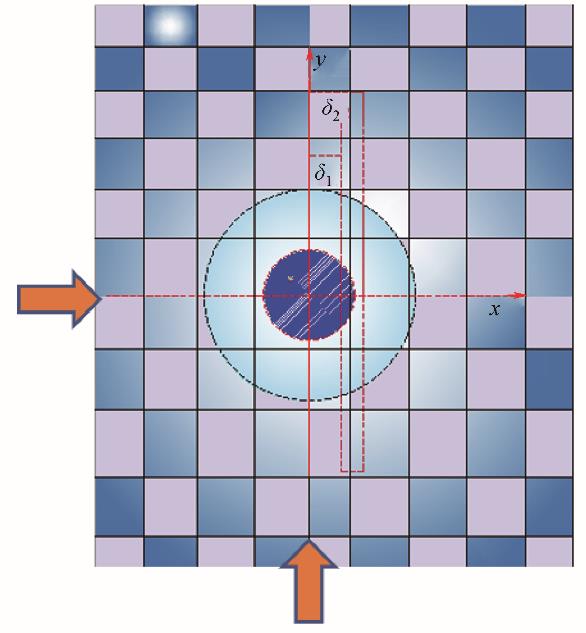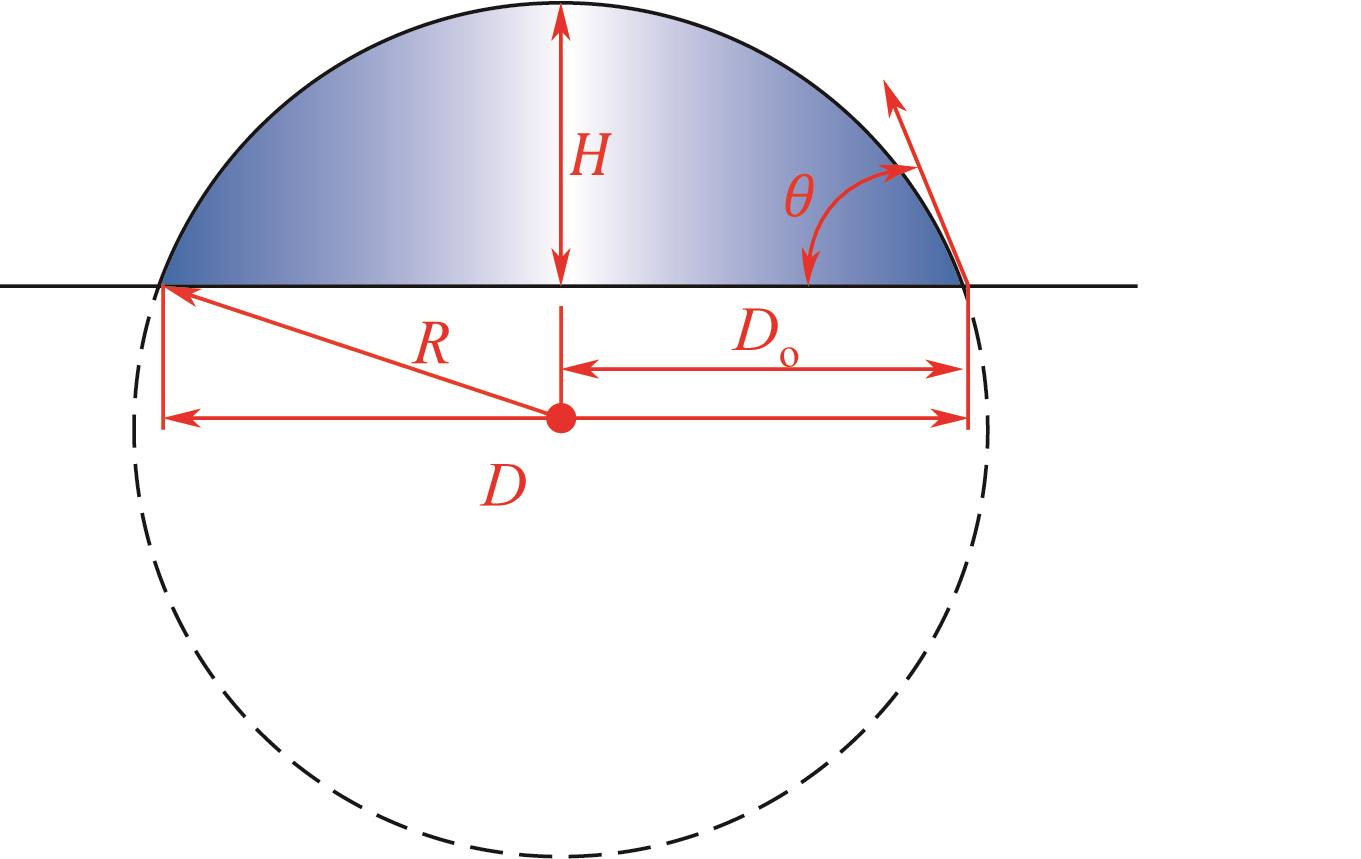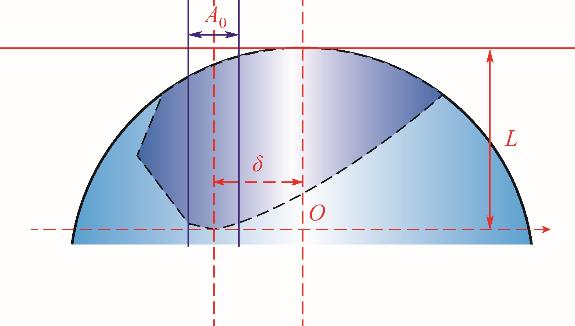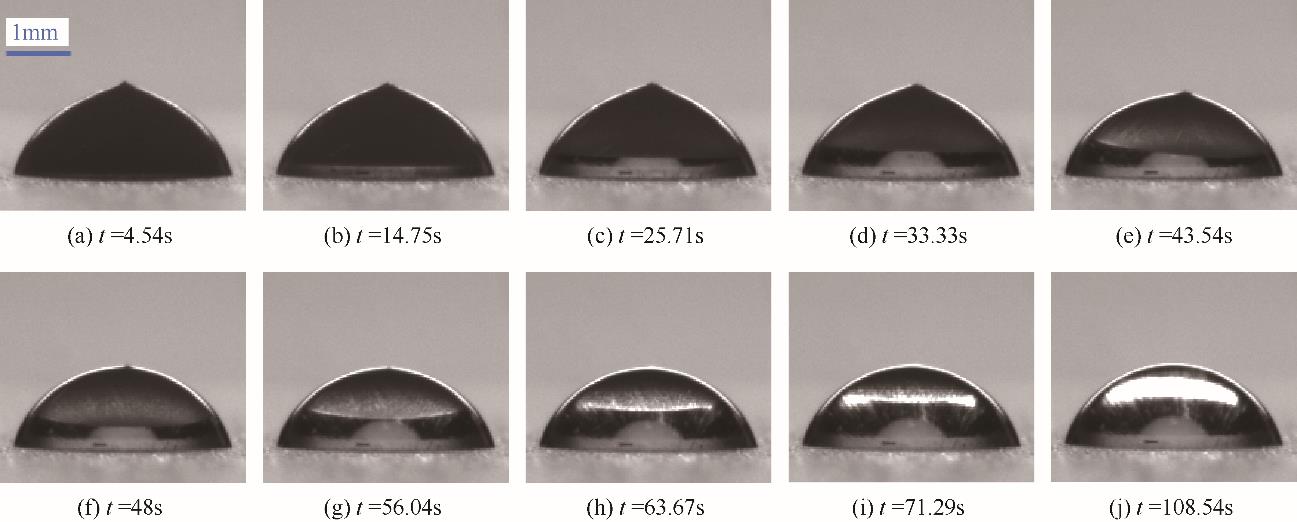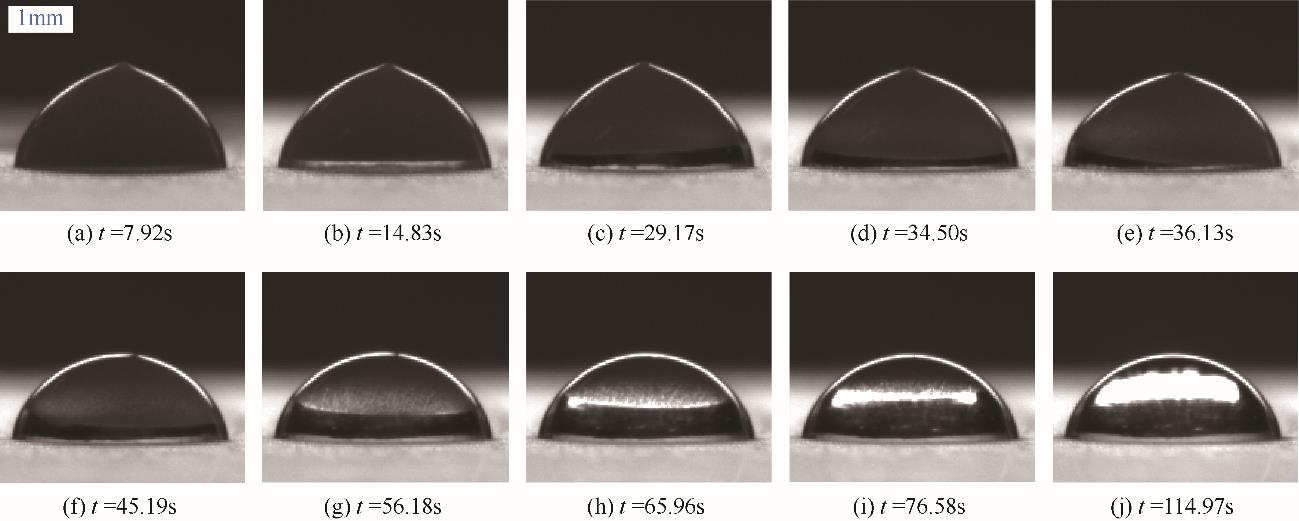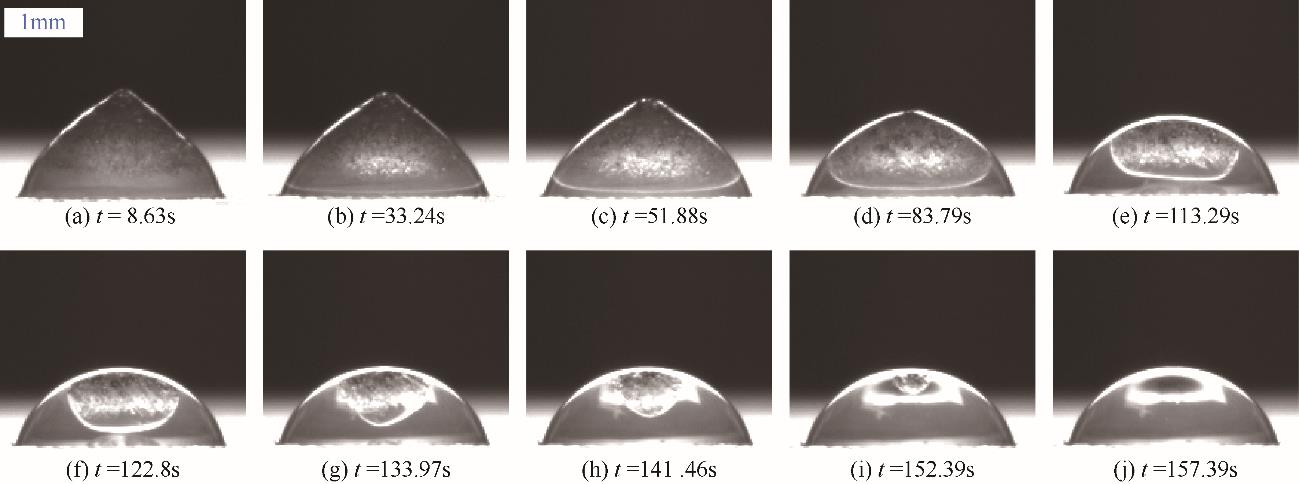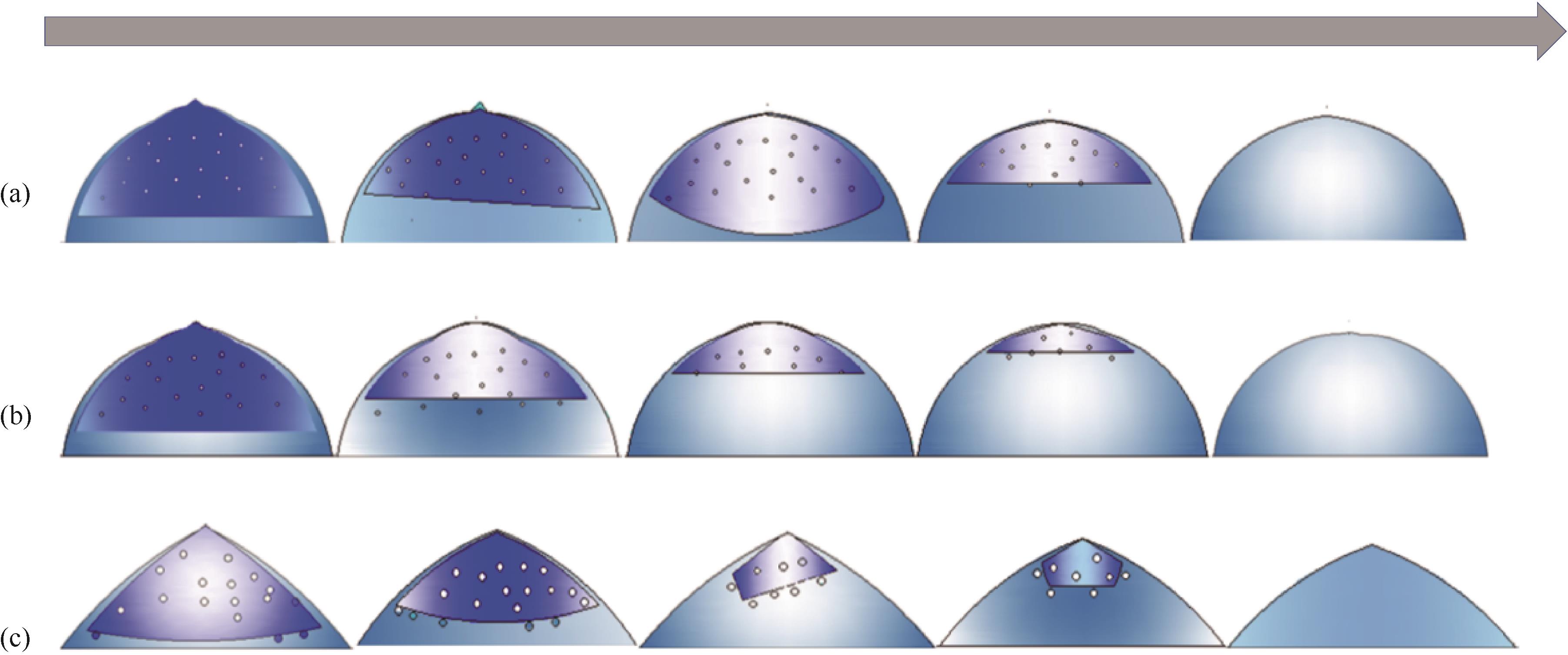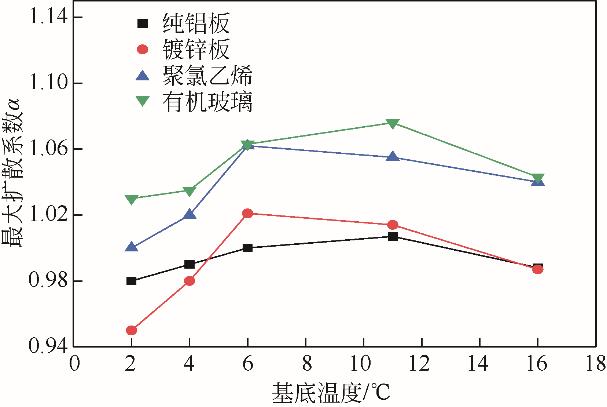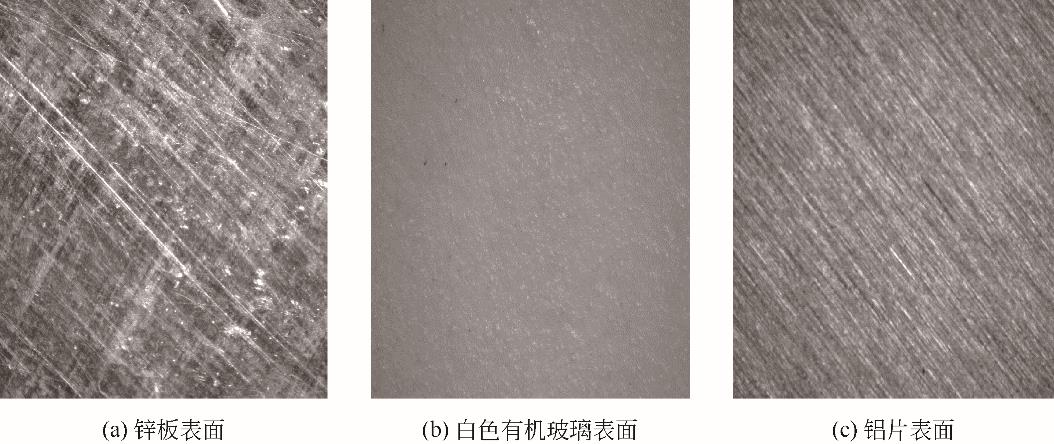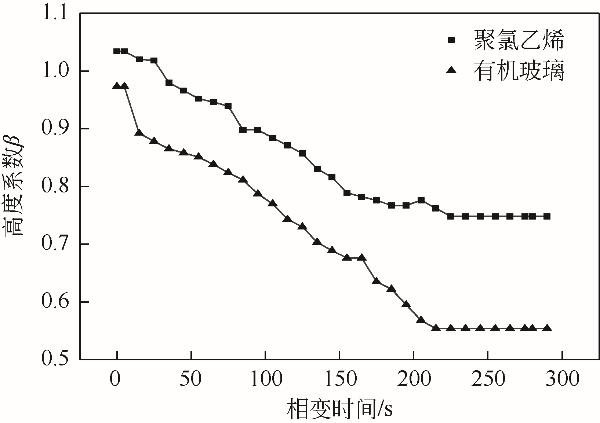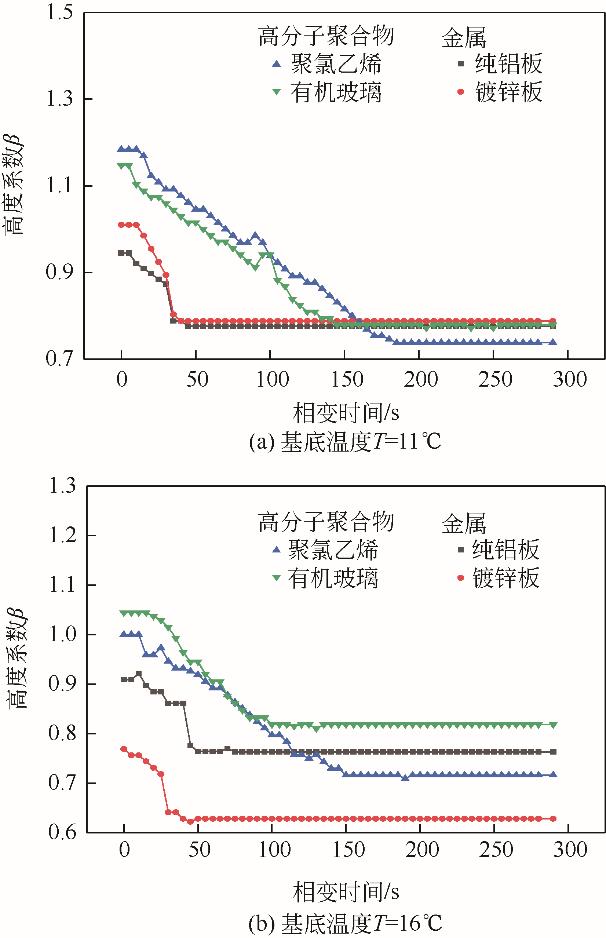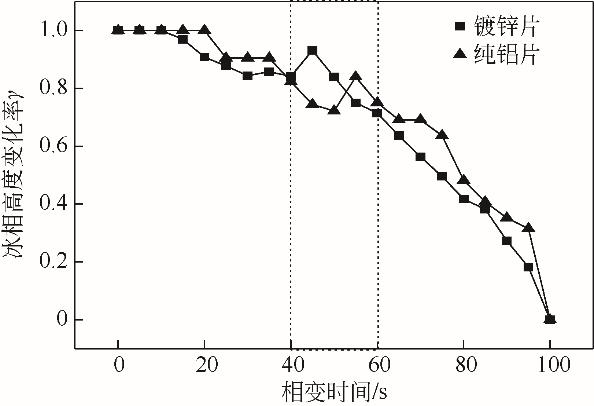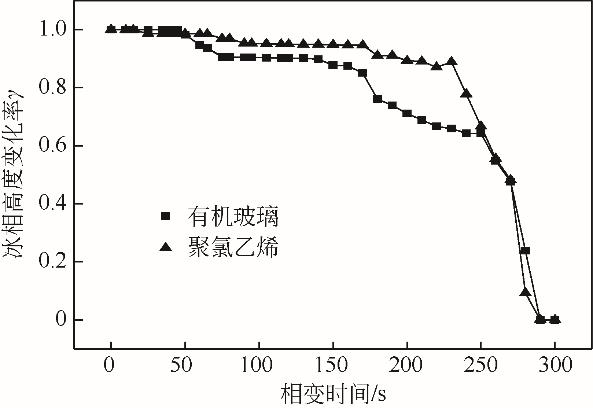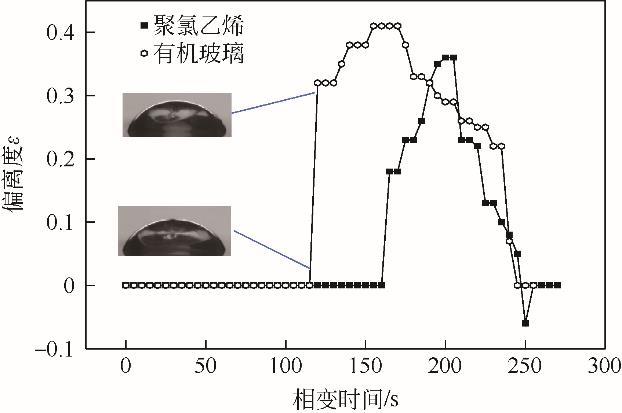化工进展 ›› 2022, Vol. 41 ›› Issue (S1): 1-14.DOI: 10.16085/j.issn.1000-6613.2021-2021
冻结液滴融化过程中的表面及界面演化特性分析
张哲( ), 郎元路, 吴巧燕, 陈佳楠, 计宏伟, 李星泊, 马妍, 陶柳倩, 谯春艳, 王瑾悦
), 郎元路, 吴巧燕, 陈佳楠, 计宏伟, 李星泊, 马妍, 陶柳倩, 谯春艳, 王瑾悦
- 天津商业大学天津市制冷技术重点实验室,天津 300134
-
收稿日期:2021-09-26修回日期:2022-03-10出版日期:2022-10-20发布日期:2022-11-10 -
通讯作者:张哲 -
作者简介:张哲(1975—),男,博士,教授,研究生导师,研究方向为换热器强化换热。E-mail:zhangzhe@tjcu.edu.cn。 -
基金资助:国家自然科学基金(12172254);天津市自然科学基金(19JCTPJC52900);天津市研究生科研创新项目(2020YJSS066);天津商业大学大学生创新训练项目(202110069171)
Analysis of surface and interface evolution characteristics of freezing droplet during melting
ZHANG Zhe( ), LANG Yuanlu, WU Qiaoyan, CHEN Jianan, JI Hongwei, LI Xingbo, MA Yan, TAO Liouqian, QIAO Chunyan, WANG Jinyue
), LANG Yuanlu, WU Qiaoyan, CHEN Jianan, JI Hongwei, LI Xingbo, MA Yan, TAO Liouqian, QIAO Chunyan, WANG Jinyue
- Tianjin Key Laboratory of Refrigeration Technology, Tianjin University of Commerce, Tianjin 300134, China
-
Received:2021-09-26Revised:2022-03-10Online:2022-10-20Published:2022-11-10 -
Contact:ZHANG Zhe
摘要:
液滴在血浆储存、航空航天等技术领域广泛存在,而其机理研究主要集中在冻结阶段,对融化阶段的研究则相对较少。故此,本文通过液滴可视化实验,发现并归纳了冻结液滴在不同材料表面、不同基底温度下融化过程的动态表面及界面演化模式,总结了液滴表面扩散系数、高度系数、相界面偏离度等形态演化参数与相变时间之间的变化规律并对其展开分析。结果表明:冻结液滴存在3种不同的表界面演化模式;在熔融中后阶段,金属材料(纯铝板、镀锌板)表面冻结液滴的冰相区以颗粒群状分布态融化,冰晶结合度低,而高分子聚合物材料[有机玻璃(PMMA)及聚氯乙烯(PVC)试板]表面冻结液滴的冰相区呈块状分布态融化,冰晶结合度高;金属类材料表面冻结液滴的相变速率高于聚合物类材料表面冻结液滴的相变速率,金属表面相变时间在100s以内,而聚合物表面冻结液滴的相变时间在300s以内;金属表面最大扩散系数分布区间为0.950~1.021,聚合物表面最大扩散系数分布区间为1.000~1.076,温度高,则各类材料表面液滴的微观前驱膜移动受阻,液滴的表面润湿过程受阻;金属表面冻结液滴的高度系数及冰相高度变化率受冰相区变化影响,聚合物表面则主要受温度影响;温度升高会使热量传递过程不稳定,加剧聚合物表面冻结液滴偏离度位移的波动性。
中图分类号:
引用本文
张哲, 郎元路, 吴巧燕, 陈佳楠, 计宏伟, 李星泊, 马妍, 陶柳倩, 谯春艳, 王瑾悦. 冻结液滴融化过程中的表面及界面演化特性分析[J]. 化工进展, 2022, 41(S1): 1-14.
ZHANG Zhe, LANG Yuanlu, WU Qiaoyan, CHEN Jianan, JI Hongwei, LI Xingbo, MA Yan, TAO Liouqian, QIAO Chunyan, WANG Jinyue. Analysis of surface and interface evolution characteristics of freezing droplet during melting[J]. Chemical Industry and Engineering Progress, 2022, 41(S1): 1-14.
温度 /℃ | 热导率 | 密度 | 比热容 | 黏度 |
|---|---|---|---|---|
| 2 | 0.556 | 4.208 | 1.6728 | |
| 4 | 0.558 | 4.204 | 1.5674 | |
| 6 | 0.565 | 1 | 4.199 | 1.4728 |
| 11 | 0.577 | 4.190 | 1.2713 | |
| 16 | 0.589 | 4.186 | 1.1111 |
表1 超纯水热物性参数
温度 /℃ | 热导率 | 密度 | 比热容 | 黏度 |
|---|---|---|---|---|
| 2 | 0.556 | 4.208 | 1.6728 | |
| 4 | 0.558 | 4.204 | 1.5674 | |
| 6 | 0.565 | 1 | 4.199 | 1.4728 |
| 11 | 0.577 | 4.190 | 1.2713 | |
| 16 | 0.589 | 4.186 | 1.1111 |
| 组件名称 | 参数名称 | 参数值及名称 |
|---|---|---|
| 摄像机 | 型号 | Allied Vision Stingray F-046B |
| 精度 | 8.3μm | |
| 最大帧率 | 61fps | |
| 变焦倍率 | 6.5 | |
| 传感器型号 | Sony ICX415 | |
| 接触角精度 | 0.3° | |
| 接触角分辨率 | 0.01° |
表2 DSA-30 液滴形状观测实验台组件及相关参数
| 组件名称 | 参数名称 | 参数值及名称 |
|---|---|---|
| 摄像机 | 型号 | Allied Vision Stingray F-046B |
| 精度 | 8.3μm | |
| 最大帧率 | 61fps | |
| 变焦倍率 | 6.5 | |
| 传感器型号 | Sony ICX415 | |
| 接触角精度 | 0.3° | |
| 接触角分辨率 | 0.01° |
| 测试材料 | 冷表面温度/℃ | 环境湿度/% | 冻结时间/s |
|---|---|---|---|
| 纯铝片 | -18 | 35 | 75 |
| 镀锌铁片 | -18 | 35 | 88 |
| 有机玻璃 | -18 | 35 | 350 |
| 聚氯乙烯 | -18 | 35 | 278 |
表3 液滴冻结过程环境工况及特征量
| 测试材料 | 冷表面温度/℃ | 环境湿度/% | 冻结时间/s |
|---|---|---|---|
| 纯铝片 | -18 | 35 | 75 |
| 镀锌铁片 | -18 | 35 | 88 |
| 有机玻璃 | -18 | 35 | 350 |
| 聚氯乙烯 | -18 | 35 | 278 |
| 物性参数 | 纯铝板 | 镀锌板 | 聚氯乙烯 | 有机玻璃 |
|---|---|---|---|---|
| 热导率 | 237 | 46.52 | 0.14 | 0.18 |
| 密度 | 2.7 | 7.25 | 1.4 | 1.18 |
| 比热容 | 0.39 | 0.091 | 1.05 | 1.424 |
| 平均表面粗糙度/μm | 0.218 | 0.557 | 0.029 | 0.013 |
表4 基板热物性参数及表面粗糙度
| 物性参数 | 纯铝板 | 镀锌板 | 聚氯乙烯 | 有机玻璃 |
|---|---|---|---|---|
| 热导率 | 237 | 46.52 | 0.14 | 0.18 |
| 密度 | 2.7 | 7.25 | 1.4 | 1.18 |
| 比热容 | 0.39 | 0.091 | 1.05 | 1.424 |
| 平均表面粗糙度/μm | 0.218 | 0.557 | 0.029 | 0.013 |
| 1 | WU X M, DAI W T, SHEN X F, et al. Visual and theoretical analyses of the early stage of frost formation on cold surfaces[J]. Journal of Enhanced Heat Transfer, 2007, 14(3): 257-268. |
| 2 | JHEE S, LEE K S, KIM W S. Effect of surface treatments on the frosting/defrosting behavior of a fin-tube heat exchanger[J]. International Journal of Refrigeration, 2007, 25: 1047-1053. |
| 3 | JING T, KIM Y, LEE S, et al. Frosting and defrosting on rigid super-hydrophobic surface[J]. Applied Surface Science, 2013, 276: 27-42. |
| 4 | RAHMAN M A, JACOBI A M. Drainage of frost melt water from vertical brass surfaces with parallel microgrooves[J]. International Journal of Heat and Mass Transfer, 2012, 55(5/6): 1596-1605. |
| 5 | RAHMAN M A, JACOBI A M. Study of frost properties and frost melt water drainage on micro-grooved brass surfaces in multiple frost/defrost/refrost cycles[J]. Applied Thermal Engineering, 2014, 64(1/2): 453-461. |
| 6 | RAHMAN M A, JACOBI A M. Experimental study on frosting/defrosting characteristics of micro-grooved metal surfaces[J]. International Journal of Refrigeration, 2015, 50: 44-56. |
| 7 | LIU Y, KULACKI F. An experimental study of defrost on treated surfaces: effect of frost slumping[J]. International Journal of Heat and Mass Transfer, 2018, 119: 880-890. |
| 8 | SATKAR D K, FARZANEH M. Superhydrophobic coatings with reduced ice adhesion[J]. Journal of Adhesion Science and Technology, 2009, 23(9): 1215-1237. |
| 9 | WANG F, LIANG C H, YANG M T, et al. Preliminary study of a novel defrosting method for air source heat pumps based on superhydrophobic fin[J]. Applied Thermal Engineering, 2015, 90: 136-144. |
| 10 | CHEN M M, YANG Z G, JIN Z Y. An experimental investigation of the melting process of an ice bead on the smooth and micro-grooved surfaces under a hot shear flow[J]. International Journal of Heat and Mass Transfer, 2019, 144: 190-210. |
| 11 | STOYANOV D B, NIXON J D, SARLAK H. Analysis of derating and anti-icing strategies for wind turbines in cold climates[J]. Applied Energy, 2021, 288: 116610. |
| 12 | FAKOREDE O, FEGER Z, IBRAHIM H, et al. Ice protection systems for wind turbines in cold climate: characteristics, comparisons and analysis[J]. Renewable and Sustainable Energy Reviews, 2016, 65: 662-675. |
| 13 | HOMOLA M C, NICKLASSON P J, SUNDSDO P A. Ice sensors for wind turbines[J]. Cold Regions Science and Technology, 2006, 46(2): 125-131. |
| 14 | JIN Z Y, ZHANG H H, YANG Z G. The impact and freezing processes of a water droplet on a cold surface with different inclined angles[J]. International Journal of Heat and Mass Transfer, 2016, 103: 886-893. |
| 15 | JIN Z Y, JIN S Y, YANG Z G. An experimental investigation into the icing and melting process of a water droplet impinging onto a superhydrophobic surface[J]. Science China(Physics, Mechanics & Astronomy), 2013, 56(11): 2047-2053. |
| 16 | DU Q, CHEN M M, XIE J X. Modelling grain growth with the generalized Kampmann-Wagner numerical model[J]. Computational Materials Science, 2021, 186: 110066. |
| 17 | IVALL J, RENAULT-CRISPO J S, COULOMBE S, et al. Ice-dependent liquid-phase convective cells during the melting of frozen sessile droplets containing water and multiwall carbon nanotubes[J]. International Journal of Heat and Mass Transfer, 2016, 101: 27-37. |
| 18 | KUMARESAN V, VELRAJ R, DAS S K. The effect of carbon nanotubes in enhancing the thermal transport properties of PCM during solidification[J]. Heat and Mass Transfer, 2012, 48(8): 1345-1355. |
| 19 | LANGMUIR I. The role of attractive and repulsive forces in the formation of tactoids, thixotropic gels, protein crystals and coacervates[J]. Journal of Chemical Physics, 1938, 6: 873-896. |
| 20 | MEYER E E, ROSENBENBERG K J, ISRAELACHVILI J. Recent progress in understanding hydrophobic interactions[J]. Proceedings of the National Academy of Sciences of the United States of America, 2006, 103: 15739-15746. |
| 21 | DERIAGUIN B, OBUCHOV E. Ultramicrometric analysis of solvate layers and elementary expansion effects[J]. Acta Physica Chim, 1936, 5: 1-22. |
| 22 | 张雨龙, 张鹏, 马非. 冰晶颗粒的浮升融化过程[J]. 上海交通大学学报, 2020, 54(5): 473-480. |
| ZHANG Y L, ZHANG P, MA F. Floating and melting process of an ice crystal particle[J]. Journal of Shanghai Jiaotong University, 2020, 54(5): 473-480. | |
| 23 | GUO W M, ZHANG Y L, MENG Z N, et al. Non-uniform melting of a spherical ice particle in free ascending[J]. International Journal of Heat and Mass Transfer, 2020, 148: 119097. |
| 24 | XU H, SHIRVANYANTS D, BEERS K L, et al. Molecular visualization of conformation-triggered flow instability[J]. Physical Review Letters, 2005, 94: 237801. |
| 25 | 王先领, 王瑾, 张云超, 等. 聚甲基丙烯酸三氟乙酯单体与分子链在金属有机框架中吸附及取向特性的理论研究[J]. 原子与分子物理学报, 2020, 37(5): 649-656. |
| WANG X L, WANG J, ZHANG Y C, et al. Theoretical study on adsorption and orientation properties of poly (2, 2, 2-trifluoroethyl methacrylate) and its molecular chain within metal-organic frameworks[J]. Journal of Atomic and Molecular Physics, 2020, 37(5): 649-656. | |
| 26 | 赵亚奇, 冯巧, 杜玲枝, 等. 关于影响高分子材料玻璃化转变温度因素的教学分析[J]. 高分子通报, 2012(6): 107-110. |
| ZHAO Y Q, FENG Q, DU L Q, et al. Teaching analysis on factors affecting the glass transition temperature of polymer materials[J]. Polymer Bulletin, 2012(6): 107-110. | |
| 27 | 齐维靖, 张萌, 潘拴, 等. InGaN/GaN超晶格厚度对Si衬底GaN基蓝光发光二极管光电性能的影响[J]. 物理学报, 2016, 65(7): 318-325. |
| QI W J, ZHANG M, PAN S, et al. Influences of InGaN/GaN sup erlattice thickness on the electronic and optical prop erties of GaN based blue light-emitting dio des grown on Si substrates[J]. Acta Physica Sinica, 2016, 65(7): 318-325. | |
| 28 | 陈洪生, 龙冲生, 肖红星. 金属基弥散燃料元件失稳肿胀的静态弹塑性模型[J]. 核动力工程, 2021, 42(3): 74-79. |
| CHEN H S, LONG C S, XIAO H X. Static elastoplastic model of metal matrix dispersion fuel element under unstable swelling condition[J]. Nuclear Power Engineering, 2021, 42(3): 74-79. |
| [1] | 王家庆, 宋广伟, 李强, 郭帅成, DAI Qingli. 橡胶混凝土界面改性方法及性能提升路径[J]. 化工进展, 2023, 42(S1): 328-343. |
| [2] | 张杰, 白忠波, 冯宝鑫, 彭肖林, 任伟伟, 张菁丽, 刘二勇. PEG及其复合添加剂对电解铜箔后处理的影响[J]. 化工进展, 2023, 42(S1): 374-381. |
| [3] | 赵景超, 谭明. 表面活性剂对电渗析减量化工业含盐废水的影响[J]. 化工进展, 2023, 42(S1): 529-535. |
| [4] | 王太, 苏硕, 李晟瑞, 马小龙, 刘春涛. 交流电场中贴壁气泡的动力学行为[J]. 化工进展, 2023, 42(S1): 133-141. |
| [5] | 王谨航, 何勇, 史伶俐, 龙臻, 梁德青. 气体水合物阻聚剂研究进展[J]. 化工进展, 2023, 42(9): 4587-4602. |
| [6] | 张振, 李丹, 陈辰, 吴菁岚, 应汉杰, 乔浩. 吸附树脂对唾液酸的分离纯化[J]. 化工进展, 2023, 42(8): 4153-4158. |
| [7] | 张超, 杨鹏, 刘广林, 赵伟, 杨绪飞, 张伟, 宇波. 表面微结构对阵列微射流沸腾换热的影响[J]. 化工进展, 2023, 42(8): 4193-4203. |
| [8] | 张凯, 吕秋楠, 李刚, 李小森, 莫家媚. 南海海泥中甲烷水合物的形貌及赋存特性[J]. 化工进展, 2023, 42(7): 3865-3874. |
| [9] | 李吉焱, 景艳菊, 邢郭宇, 刘美辰, 龙永, 朱照琪. 耐盐型太阳能驱动界面光热材料及蒸发器的研究进展[J]. 化工进展, 2023, 42(7): 3611-3622. |
| [10] | 李瑞东, 黄辉, 同国虎, 王跃社. 原油精馏塔中铵盐吸湿特性及其腐蚀行为[J]. 化工进展, 2023, 42(6): 2809-2818. |
| [11] | 杨扬, 孙志高, 李翠敏, 李娟, 黄海峰. 静态条件下表面活性剂OP-13促进HCFC-141b水合物生成[J]. 化工进展, 2023, 42(6): 2854-2859. |
| [12] | 符淑瑢, 王丽娜, 王东伟, 刘蕊, 张晓慧, 马占伟. 析氧助催化剂增强光阳极光电催化分解水性能研究进展[J]. 化工进展, 2023, 42(5): 2353-2370. |
| [13] | 李雪, 王艳君, 王玉超, 陶胜洋. 仿生表面用于雾水收集的最新研究进展[J]. 化工进展, 2023, 42(5): 2486-2503. |
| [14] | 马润梅, 杨海超, 李正大, 李双喜, 赵祥, 章国庆. 表面强化镀层对高速轴承腔密封端面变形及摩擦磨损影响分析[J]. 化工进展, 2023, 42(4): 1688-1697. |
| [15] | 梁贻景, 马岩, 卢展烽, 秦福生, 万骏杰, 王志远. La1-x Sr x MnO3钙钛矿涂层的抗结焦性能[J]. 化工进展, 2023, 42(4): 1769-1778. |
| 阅读次数 | ||||||
|
全文 |
|
|||||
|
摘要 |
|
|||||
